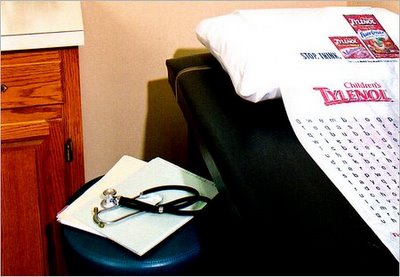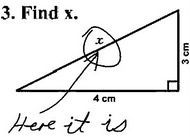Yearning for blank walls and -- silence.
I'm trying so hard to reduce the amount of sensory overload in my life - by not watching tv or listening to the radio or shopping or taking a newspaper - and the advertisers are reaching farther and farther into my life to grab me even when I'm merely walking down a street - or going to a doctor's office...
Anywhere the Eye Can See, It's Likely to See an Ad
by Louise Story for the New York Times, January 15, 2007

Add this to the endangered list: blank spaces. Advertisers seem determined to fill every last one of them. Supermarket eggs have been stamped with the names of CBS television shows. Subway turnstiles bear messages from Geico auto insurance. Chinese food cartons promote Continental Airways. US Airways is selling ads on motion sickness bags. And the trays used in airport security lines have been hawking Rolodexes.
Consumers' viewing and reading habits are so scattershot now that many advertisers say the best way to reach time-pressed consumers is to try to catch their eye at literally every turn.
"We never know where the consumer is going to be at any point in time, so we have to find a way to be everywhere," said [an ad exec]. "Ubiquity is the new exclusivity."
Last summer, Walt Disney advertised its "Little Einsteins" DVDs for preschoolers on the paper liners of examination tables in 2,000 pediatricians' offices.
Yankelovich, a market research firm, estimates that a person living in a city 30 years ago saw up to 2,000 ad messages a day, compared with up to 5,000 today.
More is on the horizon. Old-fashioned billboards are being converted to digital screens, which are considered the next big thing. They allow advertisers to change messages frequently from remote computers, timing their pitches to sales events or the hour of the day. People can expect to see more of them not only along highways, but also in stores, gyms, doctors' offices and on the sides of buildings, marketing executives say.
In some office buildings ... video screens in elevators provide news and information as well as ads. This year video screens will be placed in about 5,000 New York City taxicabs, where passengers will see both advertisements and NBC programs.
At the Amway Arena in Orlando, Fla. an interactive floor display for McDonald's last year showed the head of a teenage boy with small Big Mac burgers flying past; when people stepped on the ad, the burgers bounced away from their feet.
[Quotes from ad folks:]
"No one wants to annoy the consumer ... However, there are many annoying ads that sell products, and it's very difficult to tell what annoys one consumer and what pleases another."
A campaign that reaches people outside their homes is "very good for awareness because it's out there, it's in your face, and you can blanket a marketplace ... It's one of the last mass mediums."
"We're always looking for new mediums and places that have not been used before — it's an effort to get over the clutter. But I guess we end up creating more clutter."
Technorati Tags: Advertising, Clutter, Overload



 A few of my daughter
Melina's great posts:
A few of my daughter
Melina's great posts:








1 Comments:
1) Some of the supermarkets in my area have installed digital screens at every checkout counter. The screens run commercials, mini cooking shows, mini "health" spots, all designed of course to sell something. They are loud and obnoxious. I loathe them.
2)There are several digital screen billboards along some of our busy local freeways here in Silicon Valley. The first one was initially a disaster for two reasons: the light was so bright at night that drivers got blinded and ran into each other so they turned it down which helped; the second problem was with provocative advertising, also too distracting. Regarding the second problem, either the Powers That Be became more selective in their choice of ads or we drivers have become immune to it, we now seem to ignore the digital billboards just as we have the old-fashioned ones.
Post a Comment
<< Home